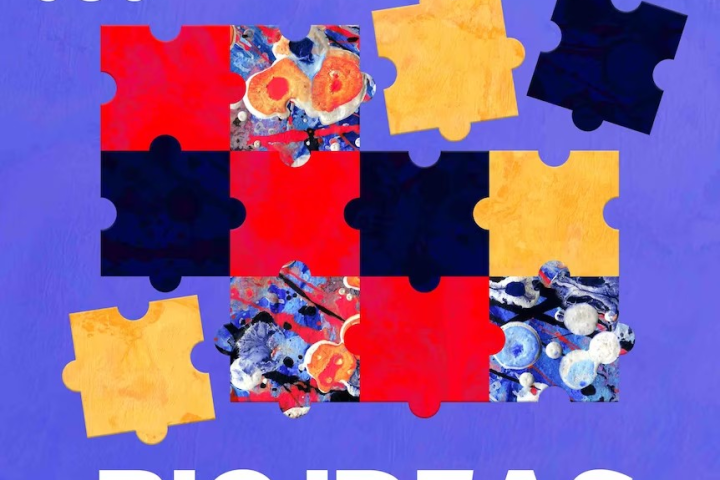“Do you realise there is no arts teaching at the UTS, and yet they sponsor an art gallery?” asks Luca Belgiorno-Nettis – architect, businessman, patron of the arts, philanthropist and passionate political idealist. “I think that’s brilliant,” he continues. “The university sees the worth of having art on the campus for its own sake.” Yes, the present gallery may be small but, he argues, its very existence demonstrates the leaders of the University of Technology, Sydney recognise what the visual arts symbolise: creativity, innovation and constantly refreshing thought patterns – qualities applicable to all forms of intellectual endeavour.
Belgiorno-Nettis, now a lean 58, is not an entirely independent witness. Sometimes described in the media as modern-day Medici, the closest thing contemporary Sydney has to a Renaissance Man (“That was more my father, not me.”), the former student of UTS has chaired the university’s arts advisory board for the past decade.
Transfield
Today we’re talking at the Sydney headquarters of Transfield Holdings, the investment and infrastructure company that his legendary father, the late Franco Belgiorno-Nettis, founded in 1956 (joined soon after by fellow Italian migrant Carlo Salteri).
Unlike most anonymous corporate HQs, this one is a physical embodiment of the Belgiorno-Nettis family credo. The office occupies a section of a refurbished historical timber finger wharf at Walsh Bay – once a hive of working class industry, now a precinct for web-based businesses and the dramatic arts. The lobby is open, airy – and full of choice pieces of contemporary sculpture and paintings.
One of the most prominent is Richard Goodwin’s sculpture, ‘Co-Isolated Slave’, which won the Art Gallery of NSW’s celebrated Wynne Prize in 2011. It features an upturned motor cycle lashed impotently on the back of an ancient butcher’s tricycle.
Broadway metamorphosis
The sculpture lobby certainly sends a message to any new visitor: Transfield Holdings is not a conventional company. And Belgiorno-Nettis believes the radical metamorphosis now under way for Broadway in general, and UTS in particular, will also have a profound impact on how people view the institution. Since it was built in the 1970s, UTS Tower has had to live with the reputation of being one of Sydney’s ugliest and least-loved buildings.
But the new Frank Gehry-designed Dr Chau Chak Wing will revolutionise the university’s public image. So too will the Ultimo Pedestrian Network, modelled on New York’s High Line, which will provide much better links between UTS, the ABC, the Powerhouse Museum and the new Darling Harbour facilities being planned by the Sydney Foreshore Authority.
Meanwhile the redevelopment of the old Carlton and United Breweries site, with the creation of Central Park, puts UTS at the very heart of an exciting technology-savvy community “The Gehry building is fantastic,” says the architect turned developer. “These things can transform the image of a place. Look what the Sydney Opera House has done for Sydney.
“We’re now also introducing public art on the entire campus, and a new gallery is proposed to replace the little one we have now. We’re hoping that a number of our existing supporters (and new ones) will help us realise what is possibly the boldest public art plan of any Australian campus.”
Belgiorno-Nettis was 26 when he attended UTS in 1980 to complete a Graduate Diploma of Urban Estate Management. “It was a mouthful,” he laughs. “But it was very useful for me. I felt I needed to do some business type studies to complement the architecture degree I’d gotten from the University of NSW.”
The UNSW degree had taken him longer than expected, partly because he’d left during his first year. “I didn’t fit in very well,” he recalls. “I was 17 and most of the university students were older. I didn’t feel comfortable.” Understandably, his father wasn’t happy, but an older, more experienced Luca returned to UNSW the following year.
Like his brothers Marco and Guido, Luca attended St Aloysius’ College in Kirribilli. He chose architecture because “like most people, I didn’t know what I wanted to do until it was upon me”. The elder Marco had studied economics “and my father, being a civil engineer, hadn’t been very happy with that, though Marco ended up doing an engineering degree at UTS after he’d finished his economics degree, so he made good in the end”.
Luca opted for UNSW rather than the University of Sydney because – in those days – the former offered a more practical architecture degree. But he’d felt frustrated. Not just by the length of the course (“ridiculously long”) but because he felt the curriculum “lacked a thematic”. As an architect student, he’d study “structure, design, sociology, town planning, construction, acoustics, etc, etc….I found it intriguing and interesting, but I was all at sea. I didn’t understand where I should focus.”
The feeling of unpreparedness continued after he left UNSW to practice architecture with a trio of companies, including Harry Seidler and Associates. It had been a deliberate decision not to work for Transfield (even though his college holidays had been spent gaining work experience at Sabemo, part owned by his father and later absorbed into the Transfield group). “I felt it would be good to get experience outside of Transfield,” says Belgiorno-Nettis. “It was robust training. But there was always that issue about how far I could really go outside Transfield without people thinking ‘this guy is only here for the interim’.”
Further studies at UTS
His decision to continue his studies at UTS came down to a determination to learn the practicalities of architecture, “the language – how a cap rate worked or what discounted cash flow was about”. He studied at UTS three nights a week. “I really respected the other students. Everyone else was working too. Everyone was serious about their studies. There was no time wasting. The teaching was great because the people doing the teaching had all come from business. So I was learning things I needed. And in the town planning aspects of the course we got to be more creative.”
By the time he’d finished at UTS in 1983 he felt it was right time to work for the company, joining Sabemo. There, he not only furthered his design and construction credentials but eventually took over the management of the family’s extensive property portfolio. That meant going to places like Karratha in WA and sorting out the everyday problems of development and property management. “The UTS degree was essential to me being able to understand those aspects,” he says.
By then Luca had married Anita. “She was the cousin of a friend of mine in Italy,” he explains. “She came to Australia as a tourist. She was supposed to come with a cousin but at the last minute the cousin had to cancel. So Anita came on her own and looked us up. She came at the beginning of 1987 and we had married by the end of the year.” In 1992 Luca, Anita and their two children moved to Kuala Lumpur. “Transfield had some historic interests in Asia, particularly Malaysia and Indonesia. Asia was felt to be the big new market. We decided to reinforce our interests there. So I put my hand up.”
As regional manager, his job was to smooth Transfield’s enterprises on many fronts in several countries. “We were the first builder to get a licence to build in Vietnam after it opened up. We ended up building four or five hotels.” Then the Asian Financial Crisis hit in 1997. “Everything went pear-shaped. Clients found it difficult to pay us, so we had lots of litigation and arbitration. It was a challenging period.” At the same time, Transfield underwent the first of two headline-making feuds of almost Capulet and Montague dimensions.
The two Italians who had worked together for so many years to make Transfield one of Australia’s most significant companies – Franco Belgiorno-Nettis and Carlo Salteri – fell out. The Transfield conglomeration was split in two. The Salteri family took the shipping and defence businesses, Franco and his family took the construction, property and infrastructure arms. The latter included such key assets as the Sydney Harbour Tunnel, Melbourne’s City Link, power stations and water treatment plants and the operations and maintenance business – now a $4 billion a year business employing 25,000 people, in which Transfield Holdings has a 15 per cent stake.
Returning to Sydney
Luca and Anita returned to Sydney in 2009. “And then we had the drama of my brother,” he says. For understandable reasons, Luca is reluctant to dwell on the family crisis. But it is well documented that Marco, then Transfield’s managing director, disagreed so fundamentally with his father and brothers Luca and Guido about the company’s future that he forced a division of the family trust. The company at the time was going through a downturn in the construction cycle and, as a consequence, the family was obliged to list the Operations and Maintenance Division, (renamed Transfield Services) on the stock market in 2001 to slash debt. The following year the construction division was sold.
“The listing was a bit of a breech birth,” Luca admits. “But we didn’t have much choice. We had to find some capacity to pay down the company overdraft.” Both Luca and Guido have continued their father’s passion for the arts. Guido chairs the Australian Chamber Orchestra and Luca the Biennale of Sydney, which Franco founded in 1973. In 2007, the family donated $4 million to the Art Gallery of NSW. They are supporters of various other cultural institutions, including the Museum of Contemporary Art and Sculpture by the Sea. Now Luca and Guido have renounced their positions as co-managing directors of Transfield Holdings and appointed a new Chief Executive, Roy McKelvie.
What’s next?
“A bit of refreshing seemed necessary, to be honest,” says Luca. “And Guido and I are interested in doing other things as well. But we’re not leaving the fort.” In Luca’s case, his major passion these days is stimulating political reform. In 2005, he established the new Democracy Foundation with its motto: “We don’t need better politicians. We need a better system.” At its heart lies Belgiorno-Nettis’ belief that elections have ruined democracy by reducing the concept to adversarial slanging matches. “Democracy was never originally conceived as such. The Ancient Greeks hardly ever had elections.”
“I’m interested in seeing how we can improve the political landscape in Australia. And for the future direction of the University, I’ve even managed to convince UTS to explore a new way to engage with their community. “I was fortunate to have attracted two grand old gentlemen from either side of politics – Labor Senator John Button and Liberal Senator Fred Chaney – to the cause. They gave me a lot of confidence, persuading me there was value in this. Since then, Geoff Gallop (former Labor premier of Western Australia), Nick Greiner (former Liberal premier of NSW), Lucy Turnbull (former Mayor of Sydney City Council, and wife of former Liberal leader Malcolm Turnbull) have given further credibility to improving our political discourse.”
“Improving politics sounds like a motherhood statement. But how does it translate? Ideological differences have effectively evaporated, leaving little but manufactured debate. The principal driver is to win and retain office, to the detriment, increasingly, of good government. Deliberative democracy holds the key. When everyday people are given the chance to deliberate together, they come up with sensible solutions. They manage to achieve something to which most elected assemblies aspire. There’s an urgent need to reinvent democracy to promote common ground.”
Words: Steve Meacham – February 2013



